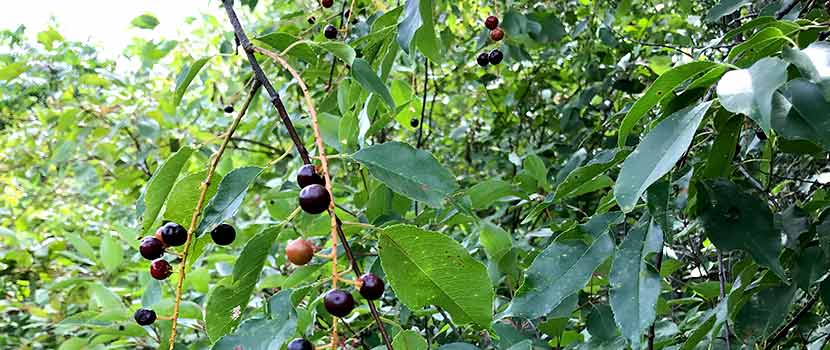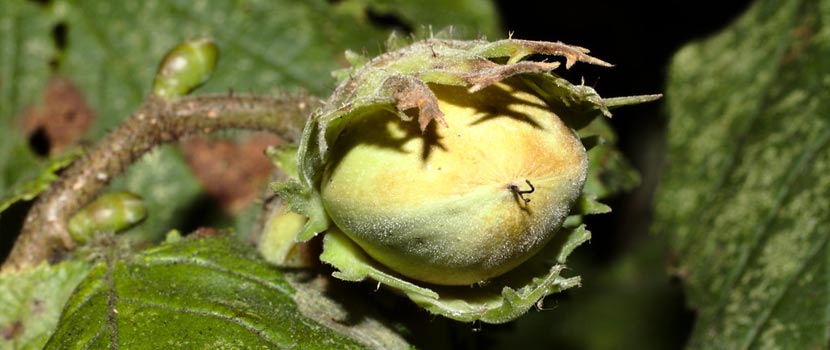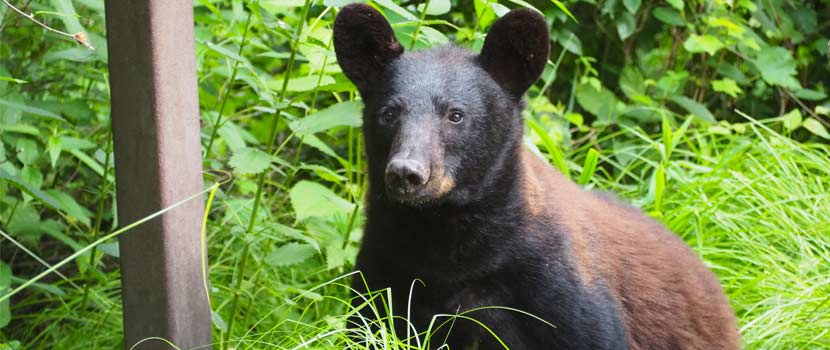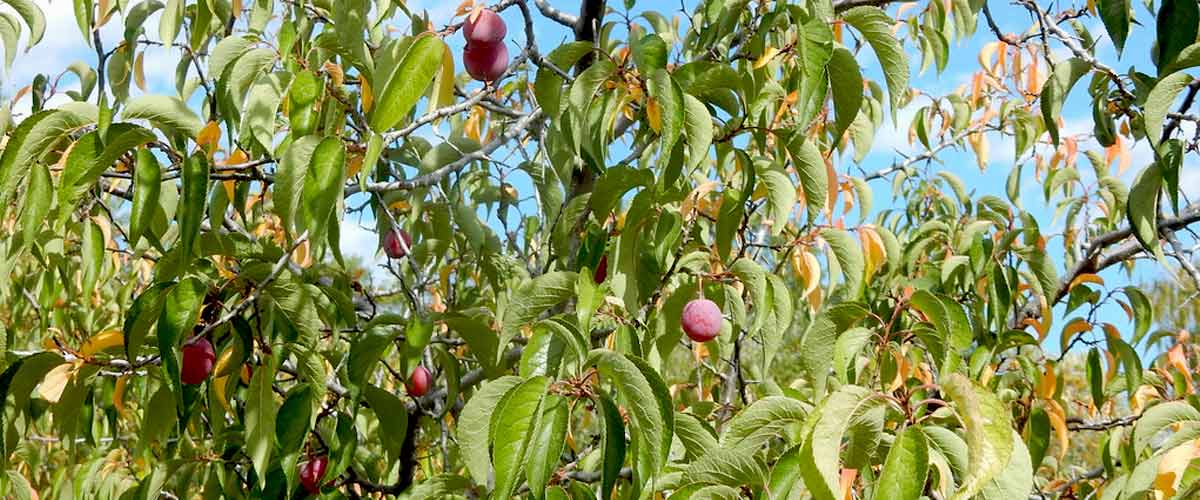
While we are known for our apple cultivars in Minnesota, (Honeycrisp, yum!), there are ongoing attempts to develop additional fruit trees that are hardy to our corner of the globe. Everything from pear to apricot to grapes have been researched or are under development.
In reality, we already have several cold hardy fruit trees and shrubs native to the state. A common one is American plum (Prunus americana), and while it may not have the most desirable fruit, it is edible and the wildlife love it. Here are the basics on this versatile shrub/small tree.
American Plum — Widespread, but Unknown
American plum is one of four native cherry species found in our region. The other three include black cherry (Prunus serotina), pin cherry (Prunus pensylvanica), and chokecherry (Prunus virginiana).
Plum is a common shrub or small tree that is easily overlooked, but it plays a large role in both forest understories and open field conditions. It is most noticeable in early spring when it is in flower.
American plum is fairly widespread within the U.S. It ranges from North Dakota south to Oklahoma and as far east as Massachusetts or Vermont. Within Minnesota, it can be found in nearly every county, but is most common in the southern one-half to two-thirds of the state.
It is well represented in Three Rivers Park District under varied conditions. It is often found within our oak forests and woodlands, but it can also be seen on the prairie/forest transitions, within riparian corridors, and in many of our open field or forest succession areas.
What’s in a Name?
There is nothing cryptic about the naming of this plant. The genus “Prunus” is Latin and translates, literally to “plum tree,” which is obviously a reference to the type of fruit it produces (more on that below). The specific epithet, americana, is just what is sounds like – found in the Americas.
Similarly, all the common names refer to the fruit and include names such as: American plum, goose plum, hog plum, river plum and sloe plum, to name several. Pretty straightforward.
How to Identify American Plum Trees
One of the two easiest times to identify this plant is in early spring when it is in flower. In Minnesota this is roughly mid-April through the end of May, depending on the year. Flowering usually occurs just before full leaf out, which allows this plant to stand out even more. The flowers themselves are white, with five petals that tend to be clustered together at the ends of twigs or branches.
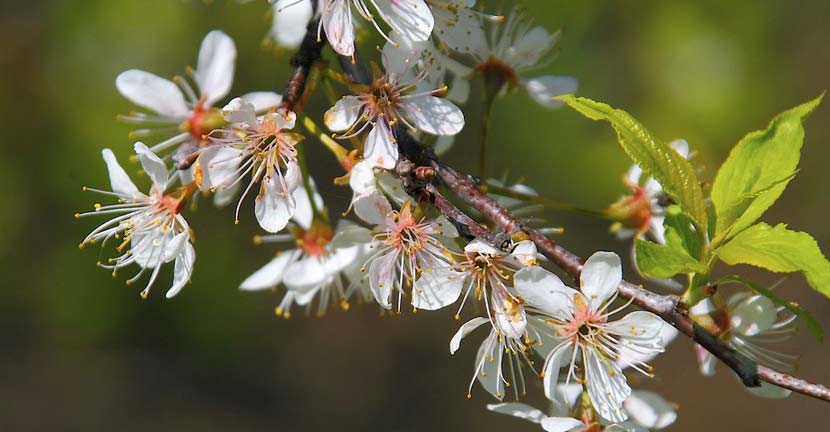
Young bark is somewhat smooth, with distinct horizontal lenticels (pores that facilitate gas exchange). At this age, the bark could be confused with other cherry species and could also be easily confused with the non-native, invasive plant common buckthorn. The bark on older specimens tends to have irregular ridges that develop into thin curling plates, somewhat like crabapples.
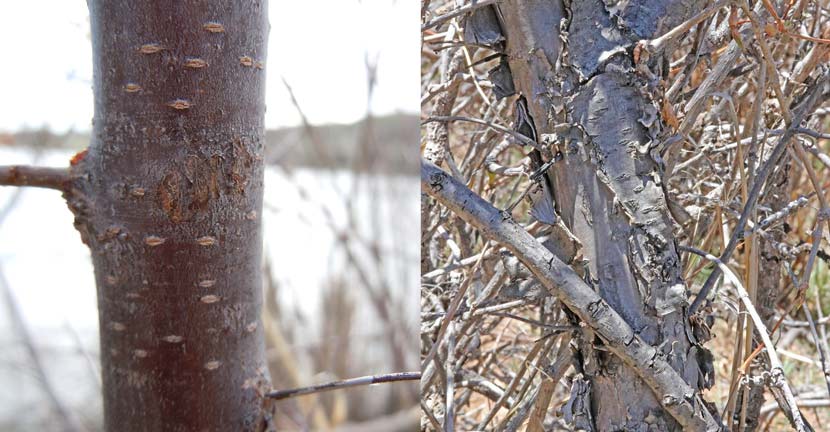
Leaves on American plum are simple and oval shaped. The leaf margin is finely toothed and there are 2 small glands that are visible with the naked eye at the base of each leaf.
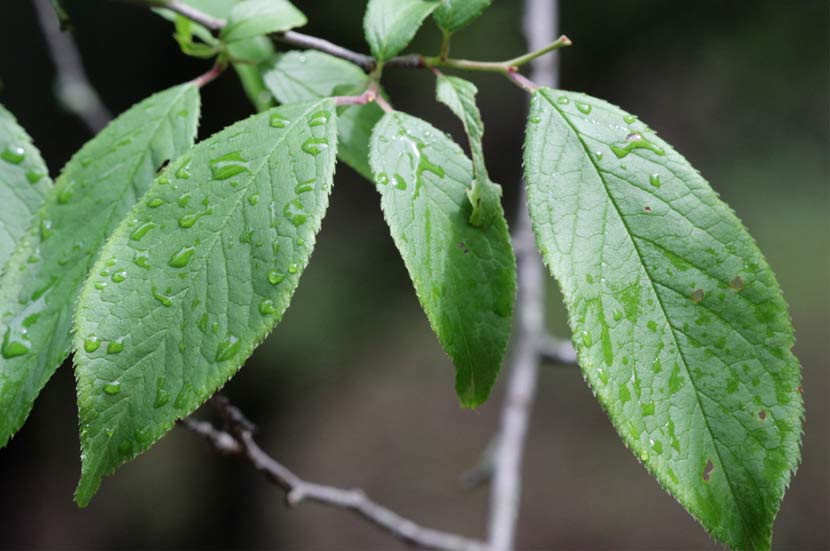
One unique characteristic of American plum is the short spurs that develop on older twigs. These can eventually turn into thorns, though not always, and it usually only happens on plants that are well established.
Finally, the fruit of American plum is a distinctive drupe that often grows in clusters. A drupe is a fleshy fruit that surrounds a single seed in the center (like, peach, apricot, mango, cherry, plum and olives). When ripe, which is about mid-August in our area, the fruit turns a bright red. This is the other time of year that American plum are easily identified in the field.
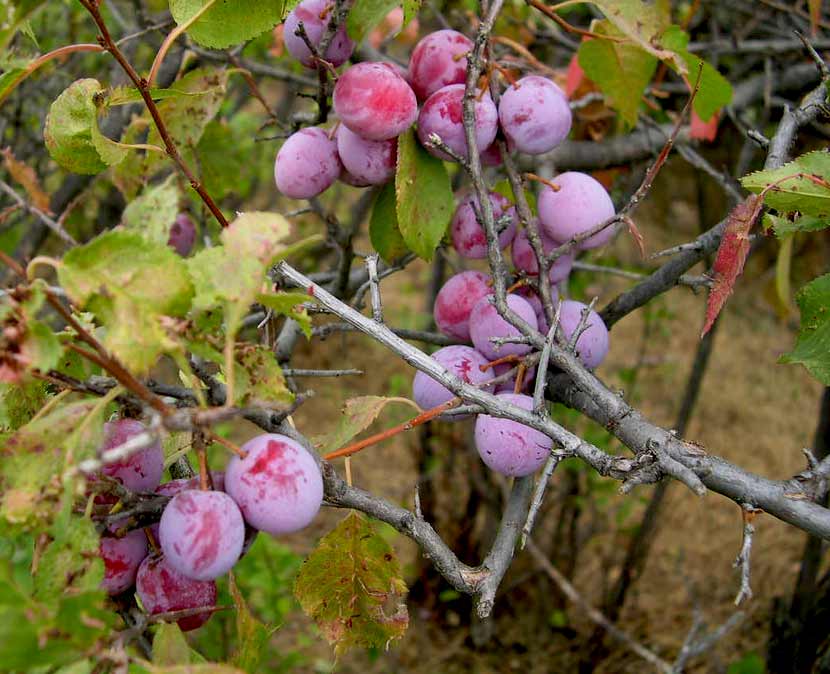
Propagation and Growing
If you are interested in growing this plant from seed (as we do here at Three Rivers), here are some tips from Propagation Specialist Missy Anderson:
“In August we start to get reports about where in the parks American plums are producing abundant fruit. After a collection site is chosen, the plums are usually picked in the second half of August, once they turn a reddish color.
The outer portion of the fruit is removed, and the ‘pit’ retained, cleaned and dried.
Our seeds are sown in the fall, at a depth of about one inch. The seedlings are generally harvested for out-planting the following fall.”
Sounds easy enough, right?
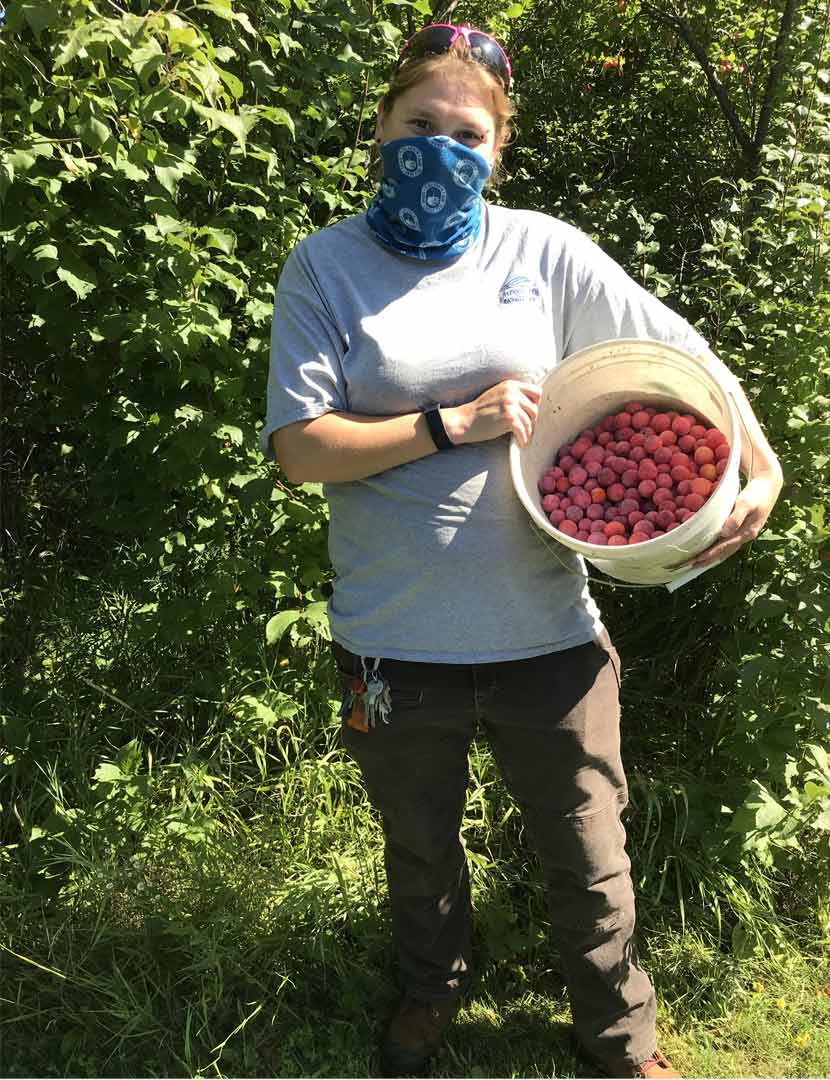
Managing American Plum Trees
There are few diseases or insects that affect this plant, and none of them are severe.
Black knot fungus (Apiosporina morbosa) is the most common pathogen affecting this plant, at least around here. It is typically found on twigs, though galls can also form on the main stem. While the fungus does girdle the portion of the plant beyond where it is growing, the damage is almost always only cosmetic in nature. Rarely will it kill the entire plant. Removing infected branches can help reduce the spread of this fungus.
The other pest that you will occasionally see on American plum is eastern tent caterpillar. While caterpillars may severely defoliate the plant, the damage is usually tolerable and nothing to be too concerned about. Only if several years of complete defoliation occur will the tree become significantly stressed.
The Many Uses of American Plum
American plum fruit is edible directly off of the plant, though you have to time it so that they are just ripe, otherwise they tend to be fairly bitter or astringent. This is due, mainly, to the skin of the plum, which is tough and bitter (due to high tannic acid content). If you can get past this, however, the fruit is great for use in jams and pies. Most of the plums you buy in the supermarket are of either European or Japanese origin.
American plum is rarely used in landscapes, due mostly to its strong tendency to sucker or send up sprouts from its roots. This characteristic can lead to it forming very dense thickets and/or encroaching on other areas of the landscape. That being said, if you need to create a hedge, there are worse plants you could use than American plum.
If you do plan on using this plant, keep in mind that it does not tolerate deep shade. Other than that American plum is adaptable to all but the wettest and driest of soil conditions.
Of course, American Indians have used this plant for a long time. It is a food source as well as medicine. The bark and roots have antibacterial properties and poultices made from this were used to treat skin problems. It was so valued as a plant that it was widely cultivated (and specific traits selected for) by several tribal nations in the eastern half of the U.S.
Aside from the human uses of this plant, American plum is an incredible wildlife resource. The dense thickets provide cover for everything from rabbits to white-tailed deer. Many game and non-game birds use these same thickets for nesting or roosting. It is a food source for a similarly wide variety of wildlife. Squirrel, wild turkey, deer, black bear and foxes are just a few of the mammals that use this plant for food (all of which have been seen in Three Rivers).
Climate Change Adaptation and Predictions
Our changing climate will likely not have a significant negative impact on the distribution or performance of this plant within Minnesota. In fact, its overall importance within natural communities may actually increase due to a projected increase in future habitat.
Currently this shrub is most commonly found in the southern half of the state, but all projected climate change scenarios indicate that suitable future conditions will expand northward significantly, but it will also likely retain its foothold within our region of the state.
What this means for Three Rivers is that we can anticipate that the overall abundance of this plant will remain fairly steady. Practically speaking, we should feel comfortable propagating and including this plant in all future forest restoration efforts.
Archive image: "20121003-FS-UNK-0056" by USDAgov is licensed under CC BY 2.0
Banner image: "Prunus americana - American (wild) plum" by Matt Lavin is licensed under CC BY-SA 2.0
About the Author

Paul is the Manager of Forestry and Horticulture at Three Rivers Park District – a position he has held for the past 10 years. Prior to that he was stomping around the wilds of Milwaukee County as the natural areas manager, and before that he was stomping around the wilds of New York City (yes, there are some) as an environmental restoration project manager for the New York City Department of Parks and Recreation. In his spare time he enjoys installing flashing on old windows.
Related Blog Posts
Species Spotlight: Black Cherry
By: Paul Kortebein
Black cherry trees are known for their fruit and valuable, beautiful wood, but there's so much more to these common native trees. Learn how to identify them, which diseases and pests affect them, and how climate change will significantly impact their location in the state.
Species Spotlight: American Hazelnut
By: Paul Kortebein
American hazelnuts are easy to grow, cold-hardy, and offer many benefits to both humans and wildlife. Read on to learn all about this plant that grows throughout Minnesota.
The Bear That Spent The Summer
By: John Moriarty Erin Korsmo
There were several bear sightings in Elm Creek Park Reserve this year. Learn more about what we saw, what it would mean to us to have regular bears in the parks, and whether we think bears will become more common in the Twin Cities.
